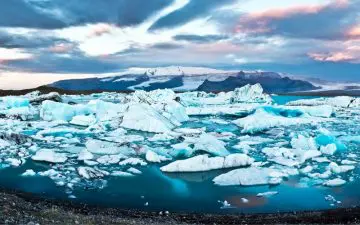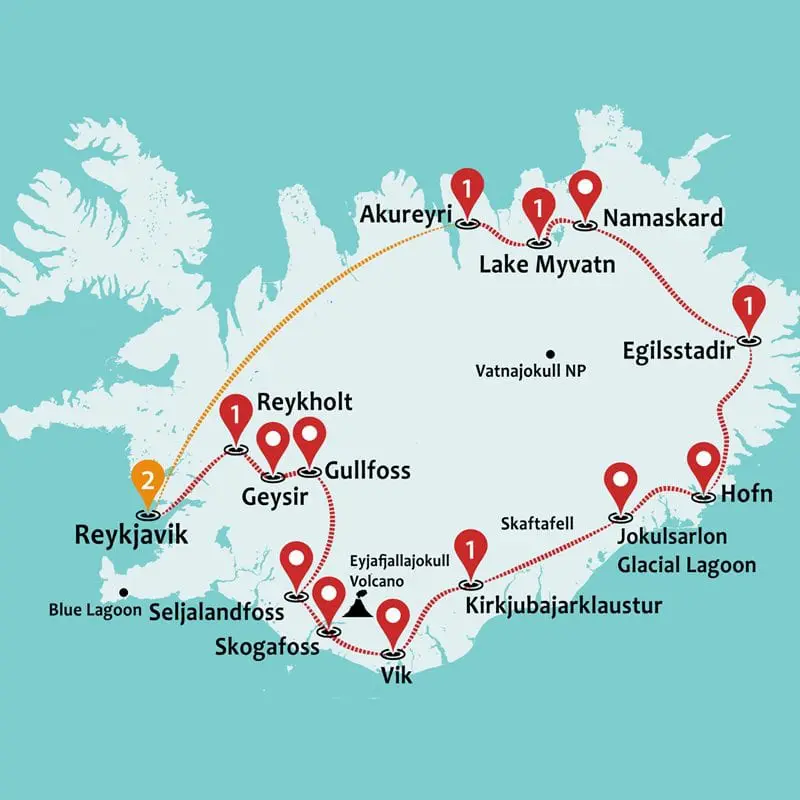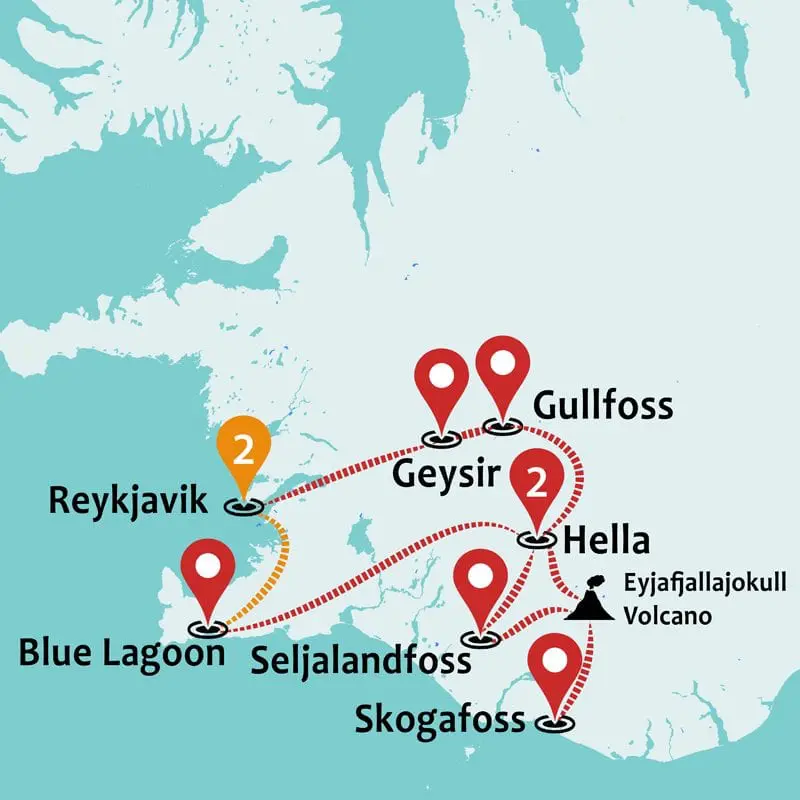Best Time To Visit Iceland
The best time to visit Iceland is from September to December when the nights are long, and you have a better chance of catching clear days for viewing the northern lights. During these months, temperatures vary between 0-15°C, and nighttime temperatures rarely drop below -3°C. It is also one of the least busy times in Iceland, making it the best time to visit the spectacular landmarks on the southern coast.
In summer, the weather in Iceland is warm and sunny, and popular spots such as Reykjavik and the Blue Lagoon are at their busiest. Also, the northern lights are not visible in the summer season due to the 20+ hours of sunlight.
In January and February, days are short with an average temperature of 0°C, experiencing frequent rain and snowfall. The atmosphere is not ideally positive to enjoy the natural wonders on the south coast around this time. As the country enters the spring season, the weather gets warm, but the chances of seeing the Aurora Borealis are thinner.
Why You Should Visit Iceland: Iceland is a destination like no other, offering visitors a stunning and otherworldly landscape that is sure to leave a lasting impression. Known as the “Land of Fire and Ice,” Iceland is home to glaciers, volcanoes, geysers, and hot springs, as well as incredible wildlife such as puffins and whales. Visitors can also experience the magical Northern Lights, a breathtaking natural light show that occurs during the winter months. Iceland’s capital city, Reykjavik, is a vibrant hub of art, music, and culture, with a thriving food scene and nightlife. Iceland is a must-visit destination for an unforgettable holiday.
Things to Consider: When planning a trip to Iceland, there are a few things to keep in mind. First, the weather can be unpredictable, so it’s important to pack warm layers and waterproof clothing. The country’s natural attractions, such as geysers, waterfalls, and glaciers, can be remote and require a fair amount of hiking or driving to reach. Although Iceland is generally safe, visitors should take precautions when driving on the sometimes icy and windy roads. Iceland can be an expensive destination, so budgeting carefully and taking advantage of free attractions, such as hiking trails and hot springs, can help keep costs down.
Monthly Travel Guide For Iceland
Travelling in Iceland in January and February
In these months, the daytime is around 5-6 hours, so there may not be enough time for sightseeing and exploring Icelandic culture in the exciting capital Reykjavik.
It is a quiet time in Iceland, and the long winter nights offer plenty of opportunities for catching the northern lights. But it is recommended to keep in mind that temperatures are usually below zero on the Southern Coast. Also, the strong winter winds make it difficult to savor the natural landmarks.

Travelling in Iceland in March and May
The temperatures are rising, and days are long enough for daytime activities, but you may expect to find the countryside covered in snow. There are still chances of seeing the northern lights on clear days.

Travelling in Iceland between June and August
Summer is the peak season in Iceland, and the most popular attractions in the south are very crowded during this time. As the summer solstice draws near, Reykjavik, Skógafoss waterfall, and Blue Lagoon get filled with tourists looking to experience the Midnight Sun.
If you are traveling to Iceland around this time, packing up an eye mask is recommended for the long-lasting Arctic light. Summer is not the best time to visit Iceland if you wish to explore the eye-catching northern lights.

Travelling in Iceland in September
September is one of the best times for the entire Icelandic experience, from exploring the volcanoes and glaciers to watching the spectacular northern lights. The crowds leave the country towards the end of August, which means that you will have the natural sites to yourself for a quiet vacation.
Iceland starts experiencing rainfall in early autumn, but the weather is perfectly moderate for sightseeing with an average temperature of 8°C.

Travelling in Iceland in October
October is a quiet time in Iceland, and the country experiences most of the rainfall around this time. As the weather conditions are more stable in the south, you may catch the northern lights when you take a Golden Circle tour. There are numerous hot springs locations in these regions. October offers the best time to visit Iceland to enjoy their healing powers.
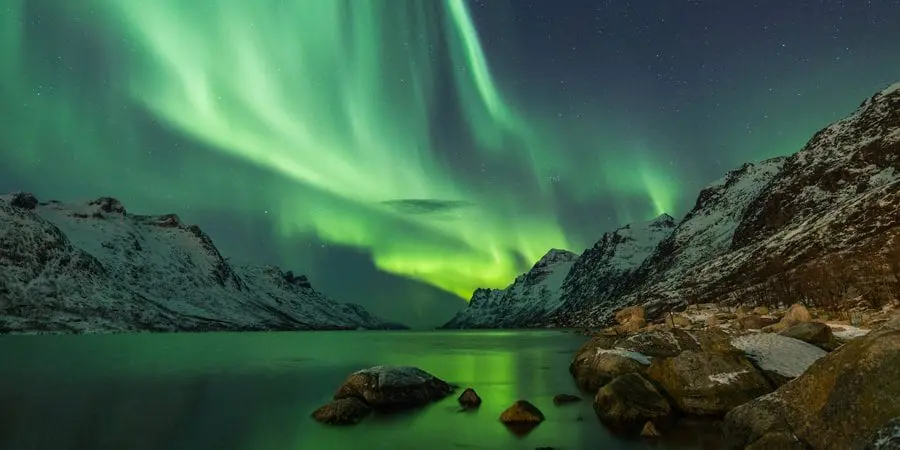
Travelling in Iceland in November
November is a perfect month for trips to Iceland, especially if you wish to experience the Northern Lights to the fullest. Clear night skies, darkness, and solar activity are the three conditions for the most beautiful viewing of the northern lights, and November brings these conditions together.
If the odds are in your favor, Reykjavik and the countryside of South Iceland are some of the best places to watch the northern lights.

Travelling in Iceland in December
December is one of the colder months, but it is the best time to visit Iceland to experience the festive cheer as New Year’s Eve draws near. The city of Reykjavik is vibrant, while the natural landmarks on the south coast will be quieter for sightseeing.
You have a better chance at seeing the northern lights as the nights are very long, which offer the most fascinating views of the Icelandic countryside. Packing up for the cold weather and winds is advisable for a comfortable experience.
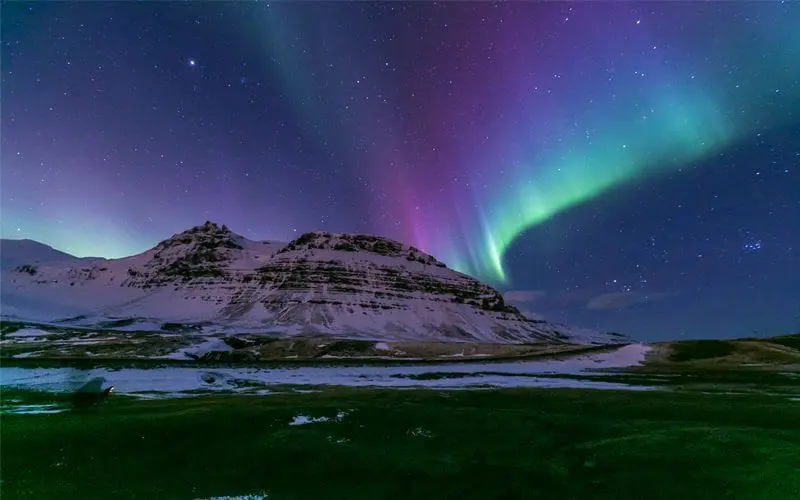
Iceland Climate & Weather Guide
| Region | Jan | Feb | Mar | Apr | May | Jun | Jul | Aug | Sep | Oct | Nov | Dec |
|---|---|---|---|---|---|---|---|---|---|---|---|---|
| Reykjavik | -2°C | -1°C | -1°C | 0°C | 3°C | 6°C | 8°C | 7°C | 5°C | 2°C | 0°C | -2°C |
| Akureyri | 55 mm-4°C | -3°C | -3°C | -1°C | 2°C | 6°C | 8°C | 7°C | 3°C | 0°C | -2°C | -4°C |
| Egilsstadir | -7°C | -4°C | -3°C | 0°C | 1°C | 3°C | 7°C | 6°C | 3°C | -1°C | 0°C | -4°C | 18 mm
| Vik | 55 mm-1°C | -1°C | 0°C | 2°C | 5°C | 6°C | 9°C | 8°C | 6°C | 2°C | 0°C | 0°C |
| Reykholt | -5°C | -3°C | -3°C | 0°C | 2°C | 5°C | 6°C | 7°C | 4°C | 0°C | -2°C | -1°C |
| Höfn | -3°C | -2°C | -2°C | 0°C | 3°C | 6°C | 7°C | 7°C | 4°C | 2°C | -2°C | -3°C |
| Kirkjubajarklaustur | -3°C | -2°C | -1°C | 0°C | 3°C | 6°C | 8°C | 7°C | 5°C | 2°C | 0°C | -2°C |
| Region | Jan | Feb | Mar | Apr | May | Jun | Jul | Aug | Sep | Oct | Nov | Dec |
|---|---|---|---|---|---|---|---|---|---|---|---|---|
| Reykjavik | 27°F | 29°F | 29°F | 33°F | 39°F | 44°F | 47°F | 46°F | 41°F | 36°F | 31°F | 28°F |
| Akureyri | 55 mm24°F | 25°F | 26°F | 30°F | 37°F | 44°F | 47°F | 46°F | 39°F | 33°F | 27°F | 24°F |
| Egilsstadir | 19°F | 24°F | 26°F | 31°F | 34°F | 39°F | 46°F | 43°F | 39°F | 30°F | 32°F | 24°F | 18 mm
| Vik | 55 mm30°F | 30°F | 32°F | 36°F | 41°F | 44°F | 49°F | 48°F | 44°F | 37°F | 33°F | 33°F |
| Reykholt | 23°F | 25°F | 25°F | 33°F | 36°F | 41°F | 44°F | 45°F | 40°F | 32°F | 28°F | 29°F |
| Höfn | 26°F | 28°F | 28°F | 32°F | 35°F | 42°F | 44°F | 44°F | 39°F | 35°F | 28°F | 26°F |
| Kirkjubajarklaustur | 26°F | 28°F | 29°F | 32°F | 38°F | 44°F | 47°F | 46°F | 42°F | 36°F | 33°F | 28°F |
| Region | Jan | Feb | Mar | Apr | May | Jun | Jul | Aug | Sep | Oct | Nov | Dec |
|---|---|---|---|---|---|---|---|---|---|---|---|---|
| Reykjavik | 136 mm | 118 mm | 112 mm | 104 mm | 91 mm | 74 mm | 82 mm | 97 mm | 133 mm | 109 mm | 94 mm | 103 mm |
| Akureyri | 55 mm187 mm | 177 mm | 173 mm | 116 mm | 119 mm | 83 mm | 135 mm | 153 mm | 193 mm | 211 mm | 207 mm | 236 mm |
| Egilsstadir | 236 mm | 226 mm | 196 mm | 141 mm | 148 mm | 90 mm | 118 mm | 126 mm | 152 mm | 221 mm | 245 mm | 279 mm | 18 mm
| Vik | 55 mm34 mm | 32 mm | 30 mm | 22 mm | 20 mm | 29 mm | 38 mm | 37 mm | 25 mm | 36 mm | 36 mm | 40 mm |
| Reykholt | 113 mm | 93 mm | 98mm | 78 mm | 48 mm | 31 mm | 44 mm | 51mm | 78 mm | 95 mm | 76 mm | 96 mm |
| Höfn | 163 mm | 130 mm | 122 mm | 95 mm | 97mm | 88 mm | 86 mm | 113 mm | 120 mm | 183 mm | 118 mm | 145 mm |
| Kirkjubajarklaustur | 113 mm | 121 mm | 86mm | 107mm | 42 mm | 30 mm | 36 mm | 47 mm | 85 mm | 120 mm | 99 mm | 117 mm |
| Region | Jan | Feb | Mar | Apr | May | Jun | Jul | Aug | Sep | Oct | Nov | Dec |
|---|---|---|---|---|---|---|---|---|---|---|---|---|
| Reykjavik | 13 | 12 | 14 | 9 | 2 | 0 | 0 | 0 | 0 | 2 | 9 | 12 |
| Akureyri | 55 mm22 | 20 | 24 | 16 | 9 | 2 | 0 | 0 | 2 | 11 | 17 | 22 |
| Egilsstadir | 19 | 18 | 22 | 14 | 10 | 2 | 0 | 0 | 1 | 9 | 16 | 20 | 18 mm
| Vik | 55 mm20 | 19 | 18 | 5 | 1 | 0 | 0 | 0 | 0 | 3 | 6 | 16 |
| Reykholt | 16 | 13 | 17 | 12 | 4 | 0 | 0 | 0 | 1 | 6 | 12 | 16 |
| Höfn | 8 | 7 | 11 | 6 | 1 | 0 | 0 | 0 | 0 | 2 | 4 | 8 |
| Kirkjubajarklaustur | 10 | 9 | 13 | 7 | 2 | 0 | 0 | 0 | 0 | 3 | 5 | 10 |
| Region | Jan | Feb | Mar | Apr | May | Jun | Jul | Aug | Sep | Oct | Nov | Dec |
|---|---|---|---|---|---|---|---|---|---|---|---|---|
| Reykjavik | 24 km/h | 25 km/h | 23 km/h | 22 km/h | 19 km/h | 15 km/h | 15 km/h | 16 km/h | 21 km/h | 21 km/h | 23 km/h | 24 km/h |
| Akureyri | 18 km/h | 17 km/h | 17 km/h | 15 km/h | 14 km/h | 12 km/h | 12 km/h | 12 km/h | 15 km/h | 15 km/h | 17 km/h | 19 km/h |
| Egilsstadir | 17 km/h | 16 km/h | 16 km/h | 14 km/h | 13 km/h | 11 km/h | 11 km/h | 11 km/h | 14 km/h | 14 km/h | 16 km/h | 17 km/h |
| Vik | 18 km/h | 18 km/h | 18 km/h | 16 km/h | 15 km/h | 13 km/h | 13 km/h | 13 km/h | 16 km/h | 16 km/h | 18 km/h | 18 km/h |
| Reykholt | 18 km/h | 18 km/h | 18 km/h | 16 km/h | 15 km/h | 13 km/h | 13 km/h | 13 km/h | 16 km/h | 16 km/h | 18 km/h | 18 km/h |
| Höfn | 17 km/h | 16 km/h | 16 km/h | 14 km/h | 13 km/h | 11 km/h | 11 km/h | 11 km/h | 14 km/h | 14 km/h | 16 km/h | 17 km/h |
| Kirkjubajarklaustur | 18 km/h | 18 km/h | 18 km/h | 16 km/h | 15 km/h | 13 km/h | 13 km/h | 13 km/h | 16 km/h | 16 km/h | 18 km/h | 18 km/h |
When to visit Iceland
Iceland Tours from September to December
September to December hosts the ideal weather for the highlight activities in Iceland. The magnificent waterfalls, volcanoes, and glaciers scattered across the north and south coasts are best explored in September and October. Temperatures are relatively warmer in the south, but the weather is comfortable enough for sightseeing. The best trips to Iceland take place during these months, as the days and nights are almost equal in length, offering the perfect chance to watch the northern lights.
It is also one of the least busy times, ideal for enjoying activities in the hot spring area of Námaskard and the Blue Lagoon. Towards the end of December, the daytime is as short as 4 hours, and the northern lights are at their most frequent. Our Iceland Circle tour offers insight into the most spectacular destinations in the Icelandic Ring Road, all of which are perfect for visiting from September to December.
Tips for visiting Iceland in autumn:
– Dressing in layers will allow you to adjust your clothing depending on the weather conditions.
– Iceland is known for its rain and mist, so waterproof gear such as a raincoat, waterproof pants, and waterproof shoes or boots are recommended.
– Keep an eye on the weather forecast and consider booking a Northern Lights tour to increase your chances of seeing this natural phenomenon.
– Sample Icelandic cuisine, which is known for its fresh seafood, lamb, and unique ingredients such as puffin and reindeer.
Explore the Golden Circle in Autumn
Autumn is the shoulder season, offering the best time to visit Iceland for adventures in South Iceland. It is an ideal season to take advantage of both the day and the night. The hot springs, mountains, bird cliffs, lighthouses, and fishing villages along the famous Golden Circle route are enjoyable in temperate weather conditions without the crowds. It is also one of the best times for sightseeing in Reykjavik and experiencing the unique Icelandic culture.
Towards the end of autumn, the skies are clear, and nights are long. There is a better chance of catching ethereal views of the northern lights around this time. Our Land of the Northern Lights tour is perfect if you wish to experience the best of Iceland in Autumn.
Why you should visit the Golden Circle in Iceland:
– The Golden Circle is home to some of Iceland’s most impressive natural wonders, including the geothermal area of Geysir, the magnificent waterfall Gullfoss, and the national park of Thingvellir.
– Thingvellir National Park is not only a geological wonder, but it is also of great cultural and historical significance. It was the site of Iceland’s first parliament, established in 930 AD.
– The Golden Circle is also a popular destination for adventure activities such as hiking, horseback riding, and snowmobiling.
– The area’s dark skies and lack of light pollution make it an ideal location for viewing the Northern Lights in Iceland.
Iceland FAQ
What’s the best time to visit Iceland for budget travellers?
The best time to visit Iceland for budget travellers is during the off-season, which is generally from September to May. During this time, accommodation prices are generally lower, and there are fewer tourists, which means that flights and tours may also be cheaper.
When to visit Iceland to see the Northern Lights?
The best time to see the Northern Lights in Iceland is from late September to early April, which is the winter season. During this time, the nights are longer and darker, providing more opportunities to witness the aurora borealis.
The peak season for the Northern Lights is from December to February when there are around 19 hours of darkness each day.
What is the best month to visit Iceland for outdoor activities?
December to February are the coldest months in Iceland, with temperatures ranging from -1°C to 3°C (30°F to 37°F) on average. This is also the season with the least daylight hours, but it is the best time to see the Northern Lights and go ice caving, snowmobiling, and skiing.
May and September are shoulder seasons, where the weather is still mild, and the crowds are smaller. It’s a good time to visit if you’re interested in hiking, photography, and nature observation.
When is the best time to experience Icelandic culture?
Some of the popular events include the Icelandic National Day in June, the Reykjavik International Film Festival in September, and the Iceland Airwaves music festival in November.
If you’re interested in outdoor activities like hiking, whale watching, or seeing the Northern Lights, the best time to visit would be in the summer months (June to August) when the weather is milder and there are more daylight hours.
However, if you’re interested in experiencing Iceland’s winter traditions like Christmas markets, ice skating, or soaking in hot springs, then the winter months (December to February) would be a better time.
When is the best time to visit Iceland for the hot springs?
During the winter months, the weather in Iceland is cold and dark, but the hot springs are at their most inviting. The contrast between the freezing temperatures and the warm water creates a truly unforgettable experience.
The Northern Lights can often be seen in Iceland’s night sky in winter, adding another layer of magic to your visit.
What are the daylight hours like in Iceland?
During the summer months, particularly around the summer solstice (around June 21st), Iceland experiences almost continuous daylight. This is known as the “Midnight Sun” and is due to the fact that the sun never fully sets below the horizon.
During the winter months, particularly around the winter solstice (around December 21st), Iceland experiences very short days with little daylight. This is known as the “Polar Night” and is due to the fact that the sun never fully rises above the horizon.
How many days do you need to visit Iceland?
To experience Iceland’s highlights and major attractions, a minimum of five to seven days is recommended. This would allow visitors to explore Reykjavik and the Golden Circle, visit the Blue Lagoon, hike a glacier or two, see the Northern Lights (during the winter months), and drive along the stunning South Coast.
What is the coldest month in Iceland?
The coldest month in Iceland is typically January, with average temperatures ranging from -1°C (30°F) to 4°C (39°F) in most parts of the country. However, it’s important to note that Iceland’s weather is highly unpredictable and can vary greatly depending on location and altitude. Visitors to Iceland during the winter months should be prepared for cold and snowy conditions, especially in the highlands and more remote areas of the country.
What are the best cities to visit in Iceland?
Reykjavik: The capital city of Iceland is a vibrant and cosmopolitan city with a rich cultural heritage, beautiful architecture, and stunning natural surroundings. It’s a great base for exploring the Golden Circle and other nearby attractions. Akureyri: Known as the capital of the North, Akureyri is the second-largest city in Iceland and a popular destination for winter sports enthusiasts. It’s also home to some of Iceland’s most beautiful gardens and parks.
Is it safe to travel to Iceland?
In general, Iceland is considered a safe country to travel to with a low crime rate and a well-established healthcare system. As with any travel, it’s important to exercise caution and take necessary safety precautions, such as being aware of your surroundings, following traffic rules, and keeping your belongings safe.
What are the most beautiful places in Iceland?
The Blue Lagoon – This geothermal spa is known for its milky blue waters, surrounded by lava fields. The Northern Lights – Iceland is one of the best places in the world to see the Aurora Borealis, a natural light display in the sky. Vatnajökull National Park – This national park is home to Vatnajökull, the largest glacier in Europe, and numerous other natural wonders. Gullfoss Waterfall – This stunning waterfall, located in the southwest of Iceland, cascades over two tiers into a deep canyon. Reykjavik – Iceland’s capital city is known for its colorful buildings, quirky art installations, and lively nightlife. Thingvellir National Park – This UNESCO World Heritage Site is home to Iceland’s largest lake, Thingvallavatn, and the Althingi, the world’s oldest parliament.
Does Iceland have nightlife?
Iceland does have a nightlife scene, particularly in the capital city of Reykjavik. While the country is known more for its natural beauty and outdoor activities, the city of Reykjavik offers a variety of bars, clubs, and restaurants that cater to a range of tastes and interests. Reykjavik’s nightlife is particularly lively on weekends, with many bars and clubs staying open until the early hours of the morning. The city has a reputation for its music scene, and there are often live performances by local bands and musicians in various venues around the city.
Which airlines fly directly into Iceland?
Several airlines operate direct flights to Iceland from various destinations. Here are some of the major airlines that fly directly to Iceland: Icelandair, Delta Airlines, United Airlines, American Airlines, WOW air, Norwegian Air Shuttle, Air Canada.
What to wear in Iceland?
Dress in layers, so you can adjust your clothing to the weather conditions. Start with a base layer of thermal underwear, followed by a mid-layer of fleece or wool, and finish with a waterproof and windproof outer layer. Bring a waterproof and windproof jacket and pants to keep you dry and warm in case of rain, snow, or wind. Look for materials like Gore-Tex or other high-quality waterproof fabrics. Don’t forget to pack warm accessories like gloves, hats, and scarves. Choose materials like wool, fleece, or synthetic materials that can keep you warm even when wet.
Comfortable and waterproof hiking boots are a must if you plan on doing any hiking or outdoor activities. Look for boots with good ankle support and a sturdy sole for better traction on rocky and uneven terrain.
What is Iceland famous for?
Iceland is known for its dramatic and breathtaking natural landscapes, including glaciers, waterfalls, geysers, and volcanic craters. Iceland is one of the best places in the world to see the Northern Lights, a natural phenomenon that occurs when charged particles from the sun collide with the earth’s atmosphere. Iceland is one of the world’s leaders in geothermal energy, using the natural heat from the earth to power homes and businesses. Iceland is one of the world’s leaders in geothermal energy, using the natural heat from the earth to power homes and businesses. Iceland has a rich history of Viking culture, with many museums and historical sites dedicated to the country’s Viking heritage.
What is the best time to eat delicious food in Iceland?
For example, during the summer months, Icelandic cuisine features fresh seafood, including langoustines, lobster, and salmon, which are typically caught locally. The summer months are also the best time to enjoy Icelandic berries, including bilberries and crowberries, which are used in desserts, jams, and sauces.
During the winter months, Icelandic cuisine features heartier dishes like smoked lamb, meat stews, and dried fish, which are perfect for warming up in the cold weather. Winter is also the time to enjoy traditional Icelandic Christmas foods, including smoked lamb, fermented skate, and leaf bread.
Do you need a visa to visit Iceland?
Whether or not you need a visa to visit Iceland depends on your nationality and the purpose of your visit. Iceland is a member of the Schengen Area, a group of 26 European countries that have abolished passport and other types of border control at their mutual borders. If you are a citizen of one of the Schengen Area countries or certain other countries, you do not need a visa to enter Iceland for stays of up to 90 days within a 180-day period.
Iceland by Season

Winter
A magical experience awaits in Iceland during winter. With its snow-covered landscapes, hot springs, and the chance to see the Northern Lights, Iceland is an iconic destination for winter travel.
From skiing and snowmobiling to relaxing in geothermal springs and exploring frozen waterfalls, there are endless opportunities for outdoor activities in Iceland’s winter wonderland.
Best Things to do in Iceland in winter:
Visit one of the popular ice caves, including Crystal Ice Cave and Vatnajökull Ice Cave. Observe humpback whales, orcas, and other species.

Spring
The best time to explore the country’s glaciers, waterfalls, and geysers with the mild weather. As the snow melts, you will witness the forces of nature in full force.
Whether you’re looking to go whale watching, visit the Blue Lagoon, or go on a hike, Iceland in spring has something for everyone.
Best Things to do in Iceland in spring:
Take a glacier hike on one of Iceland’s stunning glaciers, such as Vatnajökull. Visit the quaint town of Akureyri in northern Iceland, known for its charming architecture. Attend the Reykjavik Folk Festival.

Summer
The midnight sun and long days provide ample time for exploration in Iceland. The vibrant culture and friendly locals make for an unforgettable experience.
Don’t miss out on the incredible art festivals, summer concerts, and special events in Iceland.
Best Things to do in Iceland in summer:
Relax in a geothermal pool. Iceland is famous for its unique breed of horses, and summer is a great time to go horseback riding. Explore Reykjavik.

Autumn
Autumn is the harvest season in Iceland similar to many other countries. You will be awed by the eye-catching contrast of orange and red vegetation and silvery waters and glaciers. Autumn is the best time for a photography experience in Iceland.
Best Things to do in Iceland in autumn:
Attend Reykjavik International Film Festival. Celebrate the coming of winter with the locals through raging events like the Days of Darkness.
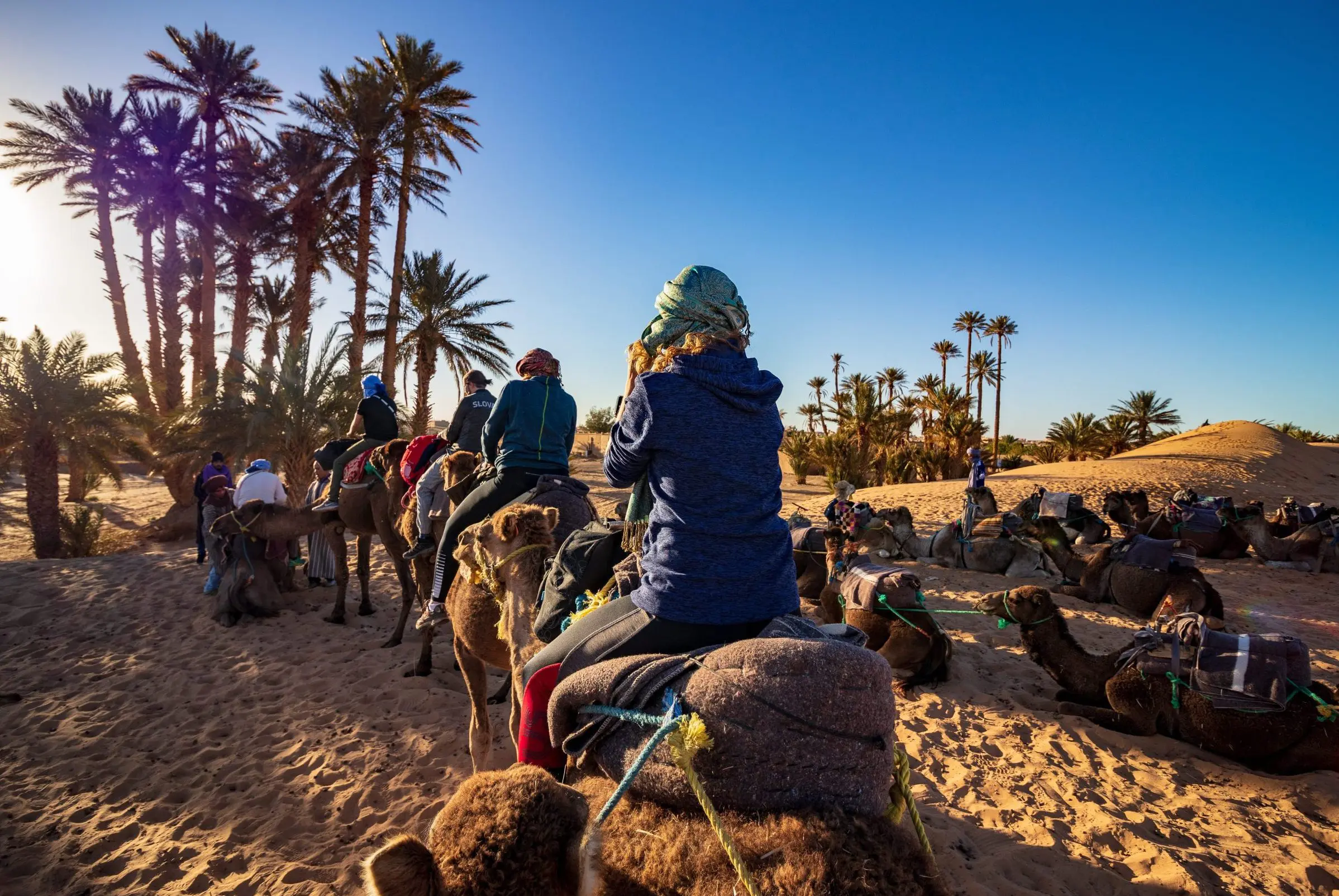 Summer Sale: 45% Off
Summer Sale: 45% Off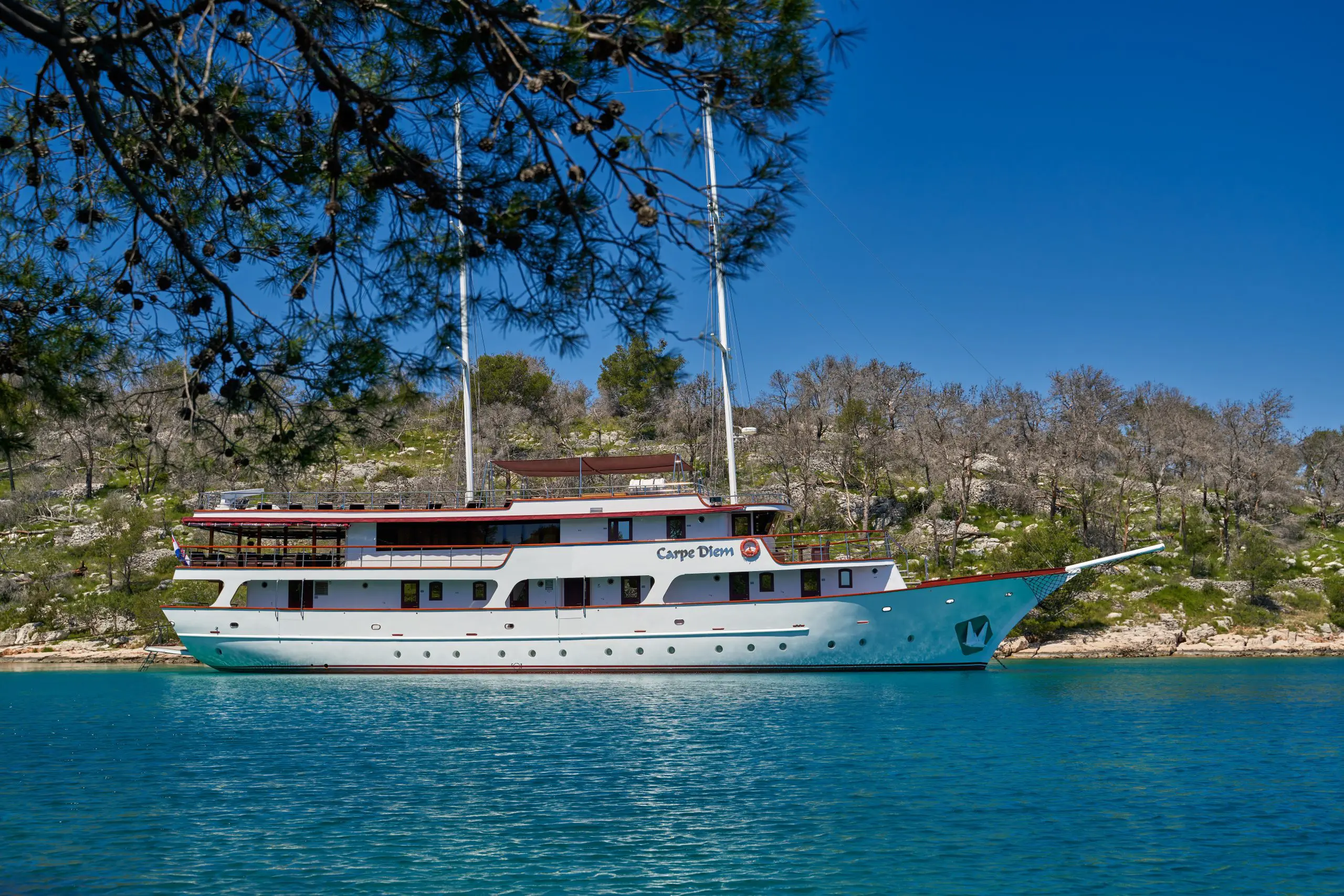 Croatia Sailing : 45% Off
Croatia Sailing : 45% Off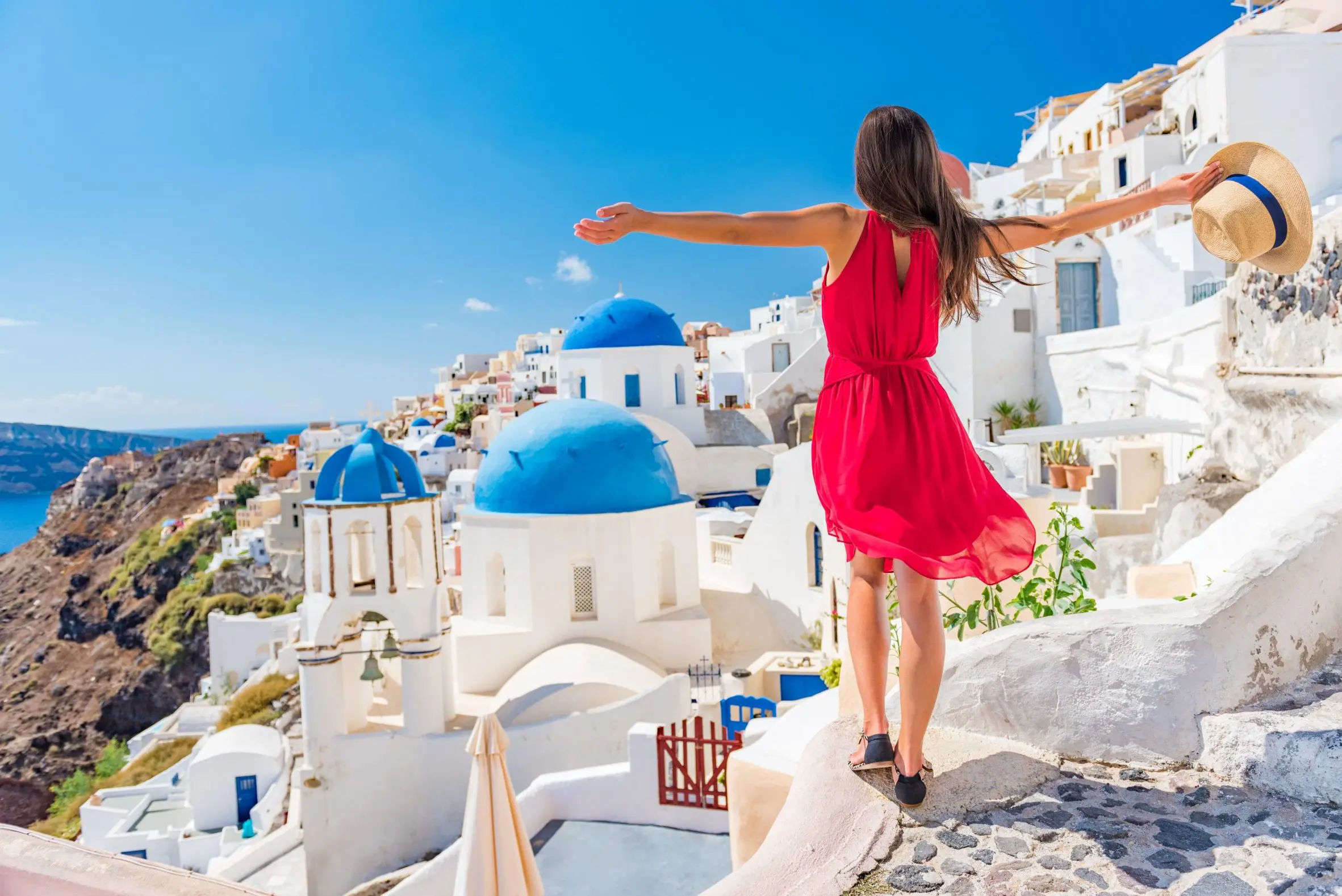 Greece Trips : Save 45%
Greece Trips : Save 45% 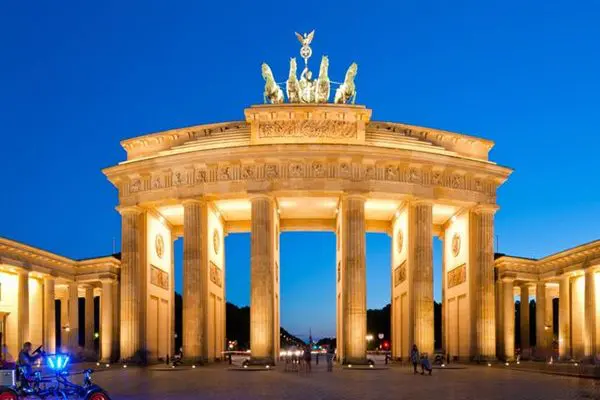 Central & Eastern Europe Tours: 45% Off
Central & Eastern Europe Tours: 45% Off  Why Travel Talk
Why Travel Talk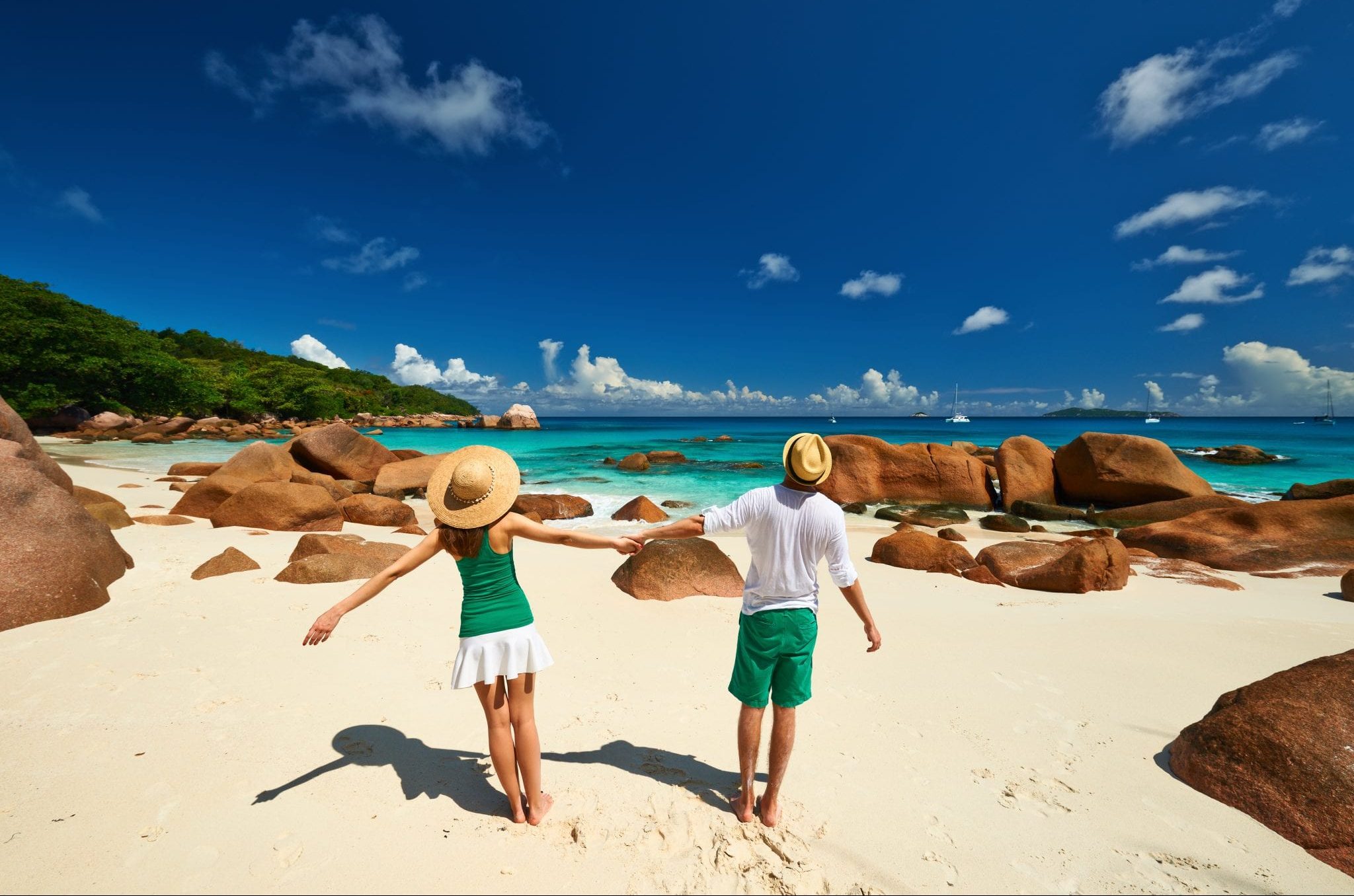 Travel Talk Blog
Travel Talk Blog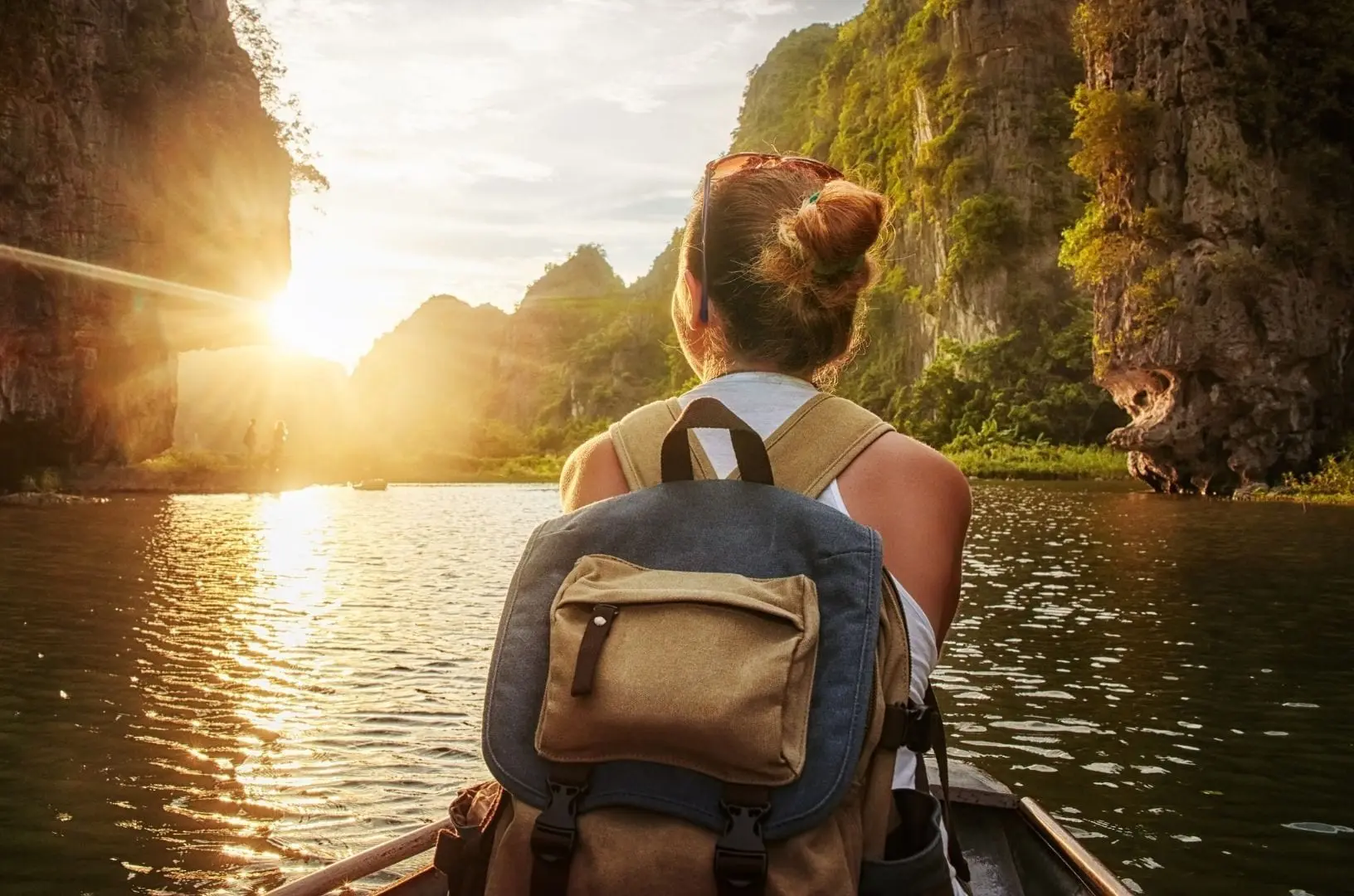 Responsible Travel
Responsible Travel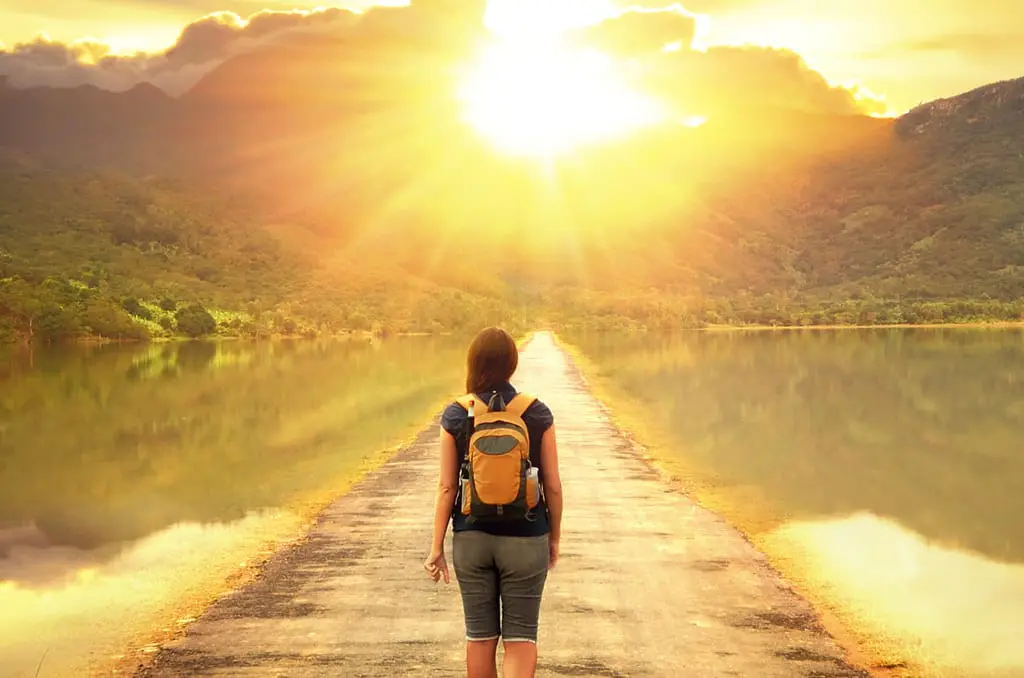 Fair Travels with Travel Talk
Fair Travels with Travel Talk